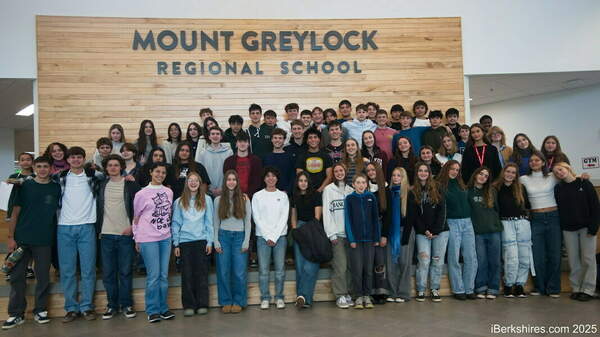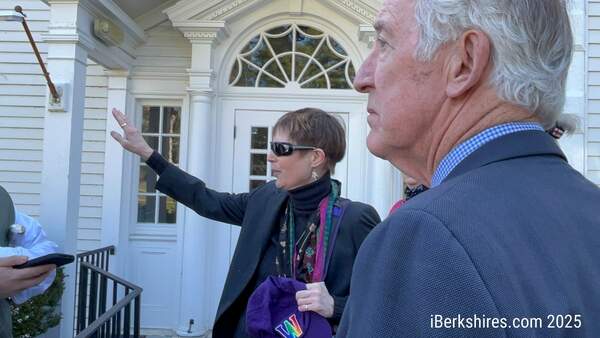
Clark Exhibit Explores Founder's China Connections
 |
|
 |
Top, an ornate 10-ton stone sarcophagus from the 5th century; left, Rutgers University professor Annette Juliano discusses a Buddhist stele that is part of 'Unearthed: Recent Archaeological Discoveries in Northern China' at the Clark Art Institute. |
For its summer 2012 exhibit, the Clark is stepping back in time, crossing the globe and reconnecting with a little known interest of one its founders.
"Unearthed: Recent Archaeological Discoveries in Northern China" runs through Oct. 21 and marks a major departure from the usual Clark fare.
Instead of the oil paintings and pastels one usually associates with a Clark summer exhibit, "Unearthed" has its centerpiece an 8-foot-by-12-foot, 10-ton stone sarcophagus from the fifth century that was removed from China's Shanxi province in 2004.
"We have no track record showing antiquities and no track record showing works from China," Clark Assistant Deputy Director Thomas Loughman noted on Monday morning.
But through founder Robert Sterling Clark, the South Street museum does have a strong heritage of exploration and scholarship in China.
In fact, while "Unearthed" is featured at the Clark's Manton Research Center and a companion exhibit at the nearby Stone Hill Center examines the legacy of Sterling Clark's 17-month research expedition through Northern China at the turn of the 20th century.
"When I came to the Clark 19 years ago as a graduate student and met (then Director) David Brooke, he told me we knew a lot about Mr. Clark from 1920 on as he was an avid diarist," Loughman said. "We knew a little about the period from 1910 to 1920 because we had receipts from the art he bought.
"But the only thing before that was this book ... that seemed so different from the image we have from 1920 on."
That book was "Through Shen-Kan: The Account of the Clark Expedition in North China, 1908-9," which Clark published in 1912.
The book is a scientific account of Clark's efforts to map northern China and, along with naturalist Arthur Sowerby, to collect biological specimens.
"Through Shen-Kan: Sterling Clark in China" runs through Sept. 16 and features photographs, documents, equipment used on the expedition and — in a real departure for the Clark — examples of the actual specimens Sowerby and Clark collected in Asia.
Some of the 80 birds and 280 mammals collected have been loaned to the Clark by the Smithsonian Institution's National Museum of Natural History — which got them from Sterling Clark in the first place.
"In 1903, Congress passed and President [Theodore] Roosevelt supported a bill to expand the Smithsonian beyond the Castle," Loughman said. "These specimens were among the first in the collection of the Museum of Natural History."
Sterling Clark, Loughman explained, graduated from Yale University a rich young man thanks to his grandfather's partnership with inventor and entrepreneur Isaac Singer. Clark pursued a commission in the Army, with whom he served in the Philippines and in China as part of a multinational peacekeeping force during the Boxer Rebellion of 1900.
After retiring from the Army and before heading to Europe to build the art collection that one day would form the core of the Clark Art Institute, Sterling Clark returned to China as a scientist.
Bridging the gap between the 1908 expedition and modern China is "Then and Now: Photographs of Northern China," which occupies the Irene M. Hunter Studio at the Stone Hill Center. The exhibit juxtaposes photos taken by Clark's expedition more than 100 years ago with contemporary photos of the same locales by Chinese photographer Li Ju.
"It's a remarkable way of documenting the changes that have taken place," Loughman said.
Of course, even more has changed in China since the days of Song Shaozu, a government official near what is now Datong, China, 216 miles west of Beijing.
Song was buried in 477 CE in an underground tomb that included a sarcophagus crafted from 101 pieces of carved stone.
 |
 |
| Left, a piece from 'Unearthed.' Right, Clark Assistant Deputy Director Thomas Loughman discusses a ring-necked pheasant collected in 1908 in the mountains between Taiyuan and Yulin, China, by an expedition led by Sterling Clark. | |
The stone structure, which has been meticulously reconstructed on the second floor of the Manton Center, is the featured attraction of "Unearthed," which also boasts a variety of archaeological finds ranging from a pair of 4-foot-high terra cotta tomb guardians to stone Buddhist reliquary from the 10th century.
Rutgers University Asian art history professor Annette Juliano, a guest curator at the Clark, said the Song tomb was one of 11 discovered at a site south of Datong, China, in 2004. Song's resting place was "the prize" because of the stone sarcophagus. It is the first of its kind to be discovered intact, and this summer's show is the first time it has been seen outside of China, Juliano said.
"The construction of this one is remarkable because it's 100 pieces of stone," she said. "They actually used a post and lintel and bracketed system in mimicking the wooden architecture that you'd see today in Chinese buildings.
"There are many other sarcophagi, but they're just made of slabs of stone that are sort of boxed together, and they put a roof on it. With this, they made an effort to build it as if it was actually a wooden building."
In addition to architecture, there is plenty of art in "Unearthed" to appeal to more traditional Clark patrons. Funerary art is a significant discipline of study in every major culture — from King Tut's tomb to the catacombs of Rome — and the pieces on display at the Clark reflect a period of change in China, during which Buddhism was on the rise and Mongolian nomads were asserting their influence.
"There's an interesting mixture of ethnicities and cultures coming together," Juliano said.
On Sunday, June 24, from 11 a.m. to 4 p.m., the Clark will open the doors of "Unearthed," "Through Shen-Kan" and "Then and Now" for free admission as part of its summer Family Day celebration. In addition to art projects, a dragon parade and live performances of Chinese music, visitors of all ages will have a chance to explore treasures not likely to be seen on this continent again in anyone's lifetime.
"We have never done a show as family-oriented as this," Clark Director Michael Conforti said on Monday. "A show full of mystery and objects coming out of the earth.
"It's serious. And Annette [Juliano] is serious. But you don't have to be serious to appreciate it."
Tags: China, Clark Art, exhibit, museum,















